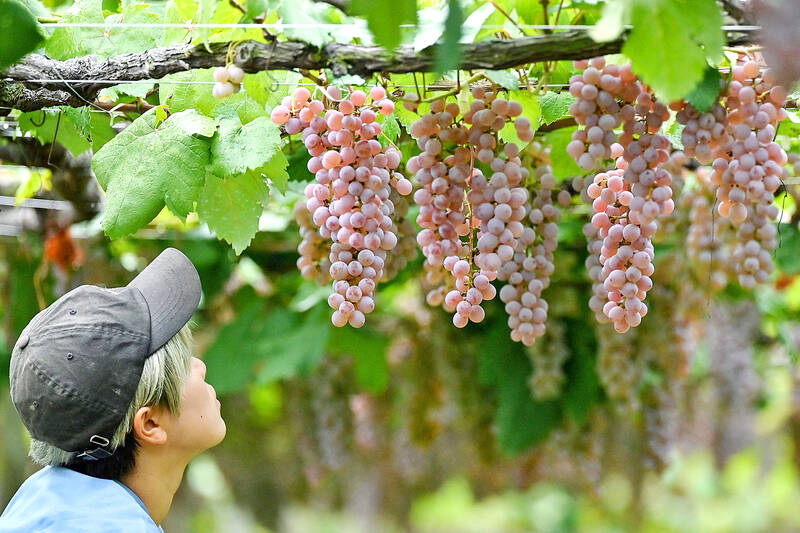At a Buddhist temple on a wooded hillside in Japan, grapes and wine bottles are given as offerings, and the head monk is also the honorary president of a vineyard cooperative.
Officially, it is known as Daizenji, but it has been nicknamed the “grape temple” because of its deep-rooted links to the history of grape production in the country.
Daizenji is in Yamanashi Prefecture, about 100km west of Tokyo, which is famous as the home of Mount Fuji, and more recently as Japan’s top winemaking destination.

Photo: AFP
“At other temples, they offer sake, but here, we offer wine. That’s unique in Japan,” head monk Tesshu Inoue, 75, said as he recounted the mythic origins of his temple.
In 718 AD, a famous Japanese Buddhist monk and traveler called Gyoki is said to have met the Buddha of medicine, known in Japanese as Yakushi Nyorai, in a dream at the spot where the temple stands today.
In his hand, Nyorai held a bunch of grapes — inspiring Gyoki to found Daizenji and establish the local vineyard culture, teaching Yamanashi residents how to make wine for medicinal purposes.
A different legend claims farmer Kageyu Amemiya was the first to begin the cultivation of grapes in Japan, in the same area, but more than 450 years later, in 1186.
DNA analysis has found that koshu — the oldest grape variety grown in the mountainous region — is a hybrid of a vine species originally cultivated in Europe and a wild Chinese vine.
That suggests it could have traveled the Silk Road on its way to Japan, the same way Buddhism established itself in Asia.
The Web site for Yamanashi’s “koshu valley,” supported by the local chamber of commerce, suggests seeds or vines from China might have been planted in the grounds of temples and rediscovered by chance much later.
However, it was only in the Meiji era from 1868 to 1912 — a period that saw an explosion in interest in the Western world — that wine production started in Japan.
With its fertile soil and long history of grape growing, Yamanashi was the obvious choice for the first vineyards, and even today, Daizenji is surrounded by grapes growing on pergola structures.
At the altar, grapes and bottles sit as offerings, while a small shrine conceals an antique cherrywood statue of Yakushi Nyorai with his famous bunch of grapes.
The lacquered sculpture, decorated with gold leaf, is a precious artifact belonging to the temple, and is only shown in public every five years.
Daizenji also sells its own grapes, and bottles of wine bearing the temple’s name. “Growing grapes, making wine, it’s a good deed,” Inoue said with a smile. “It’s good karma.”

The Burmese junta has said that detained former leader Aung San Suu Kyi is “in good health,” a day after her son said he has received little information about the 80-year-old’s condition and fears she could die without him knowing. In an interview in Tokyo earlier this week, Kim Aris said he had not heard from his mother in years and believes she is being held incommunicado in the capital, Naypyidaw. Aung San Suu Kyi, a Nobel Peace Prize laureate, was detained after a 2021 military coup that ousted her elected civilian government and sparked a civil war. She is serving a

REVENGE: Trump said he had the support of the Syrian government for the strikes, which took place in response to an Islamic State attack on US soldiers last week The US launched large-scale airstrikes on more than 70 targets across Syria, the Pentagon said on Friday, fulfilling US President Donald Trump’s vow to strike back after the killing of two US soldiers. “This is not the beginning of a war — it is a declaration of vengeance,” US Secretary of Defense Pete Hegseth wrote on social media. “Today, we hunted and we killed our enemies. Lots of them. And we will continue.” The US Central Command said that fighter jets, attack helicopters and artillery targeted ISIS infrastructure and weapon sites. “All terrorists who are evil enough to attack Americans are hereby warned

Seven wild Asiatic elephants were killed and a calf was injured when a high-speed passenger train collided with a herd crossing the tracks in India’s northeastern state of Assam early yesterday, local authorities said. The train driver spotted the herd of about 100 elephants and used the emergency brakes, but the train still hit some of the animals, Indian Railways spokesman Kapinjal Kishore Sharma told reporters. Five train coaches and the engine derailed following the impact, but there were no human casualties, Sharma said. Veterinarians carried out autopsies on the dead elephants, which were to be buried later in the day. The accident site

‘EAST SHIELD’: State-run Belma said it would produce up to 6 million mines to lay along Poland’s 800km eastern border, and sell excess to nations bordering Russia and Belarus Poland has decided to start producing anti-personnel mines for the first time since the Cold War, and plans to deploy them along its eastern border and might export them to Ukraine, the deputy defense minister said. Joining a broader regional shift that has seen almost all European countries bordering Russia, with the exception of Norway, announce plans to quit the global treaty banning such weapons, Poland wants to use anti-personnel mines to beef up its borders with Belarus and Russia. “We are interested in large quantities as soon as possible,” Deputy Minister of National Defense Pawel Zalewski said. The mines would be part